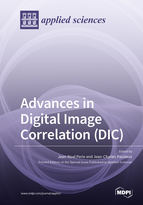Advances in Digital Image Correlation (DIC)
A special issue of Applied Sciences (ISSN 2076-3417). This special issue belongs to the section "Optics and Lasers".
Deadline for manuscript submissions: closed (28 February 2019) | Viewed by 65391
Special Issue Editors
Interests: identification of constitutive parameters; full field measurements; digital image correlation; experimental mechanics; composite materials
Interests: numerical methods in computational and experimental mechanics; global digital image correlation; identification of mechanical properties; high performance computing
Special Issue Information
Dear Colleagues,
Digital Image Correlation (DIC) has become the most popular full field measurement technique in experimental mechanics. It is a versatile and inexpensive measurement method that provides a large amount of experimental data. Because it can take advantage of a huge variety of image modalities, the technique allows covering a wide range of space and time scales. Stereo extends the scope of DIC to non-planar cases, which are more representative of industrial use cases. With the development of tomography, Digital Volume Correlation now gives access to volumetric data. It makes it possible to study the behavior of materials and structures.
However, using DIC data for quantitatively validating models or identifying many constitutive parameters accurately is still not straightforward. One of the reasons lies in the tricky compromises between measurement resolution and spatial resolution. Second, the question of the boundary conditions is still an open question. Another reason is that the measured displacements are not directly comparable with usual simulations. Finally, the use of full field data leads to new computational challenges.
In this Special Issue, we would like to show how recent developments of algorithms or new methodologies could help to reduce the amount of measurement and identification uncertainties, to deal with the huge amount of data or to bridge the gap between measurements and simulations.
Dr. Jean-Noel Perie
Dr. Jean-Charles Passieux
Guest Editors
Manuscript Submission Information
Manuscripts should be submitted online at www.mdpi.com by registering and logging in to this website. Once you are registered, click here to go to the submission form. Manuscripts can be submitted until the deadline. All submissions that pass pre-check are peer-reviewed. Accepted papers will be published continuously in the journal (as soon as accepted) and will be listed together on the special issue website. Research articles, review articles as well as short communications are invited. For planned papers, a title and short abstract (about 100 words) can be sent to the Editorial Office for announcement on this website.
Submitted manuscripts should not have been published previously, nor be under consideration for publication elsewhere (except conference proceedings papers). All manuscripts are thoroughly refereed through a single-blind peer-review process. A guide for authors and other relevant information for submission of manuscripts is available on the Instructions for Authors page. Applied Sciences is an international peer-reviewed open access semimonthly journal published by MDPI.
Please visit the Instructions for Authors page before submitting a manuscript. The Article Processing Charge (APC) for publication in this open access journal is 2400 CHF (Swiss Francs). Submitted papers should be well formatted and use good English. Authors may use MDPI's English editing service prior to publication or during author revisions.
Keywords
- Digital Image Correlation
- Stereo Digital Image Correlation
- Digital Volume Correlation







